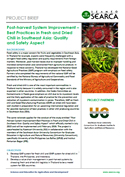Post-harvest System Improvement – Best Practices in Fresh and Dried Chili in Southeast Asia: Quality and Safety Aspect
Background
 Food safety is a major concern for fruits and vegetables in Southeast Asia. In Thailand, exports are frequently challenged with stringent food safety regulations and quality requirements from foreign markets. Moreover, post-harvest losses, due to improper handling and microbial contamination, also constrained fresh agricultural produce. In response, Thailand developed the National Good Agricultural Practices (GAP) program with emphasis on food safety. Farmers who completed the requirements of the national GAP are certified by the National Bureau of Agricultural Commodity and Food Standards of the Ministry of Agriculture and Cooperatives.
Food safety is a major concern for fruits and vegetables in Southeast Asia. In Thailand, exports are frequently challenged with stringent food safety regulations and quality requirements from foreign markets. Moreover, post-harvest losses, due to improper handling and microbial contamination, also constrained fresh agricultural produce. In response, Thailand developed the National Good Agricultural Practices (GAP) program with emphasis on food safety. Farmers who completed the requirements of the national GAP are certified by the National Bureau of Agricultural Commodity and Food Standards of the Ministry of Agriculture and Cooperatives.
Among other commodities, fresh and dried chili is one of the most important commodities in Thailand, mainly because it is widely consumed in the country and is exported in other countries. In addition, the Codex Committee on Contaminants in Foods gave emphasis on chili due to its mycotoxin levels and the likely application of the code of practice for the prevention and reduction of mycotoxin contamination in spices. Therefore, GAP on fresh chili and Good Manufacturing Practices (GMP) on dried chili have been well studied in preparation for an upcoming international regulation and for possible replication of best practices in other chili producing countries in Southeast Asia (SEA).
The same rationale applies for the conduct of the study entitled "Post Harvest System Improvement-Best Practices in Fresh and Dried Chili in Southeast Asia: Quality and Safety Aspect," which officially started in July 2015 and was implemented until February 2016. The project was spearheaded by Kasetsart University (KU), and in collaboration with the members of the Southeast Asian University Consortium for Graduate Education in Agriculture and Natural Resources (University Consortium), specifically University of the Philippines Los Baños (UPLB) and Institut Pertanian Bogor (IPB).
Objectives
- Develop a GAP system for fresh chili and GMP system for dried chili in Thailand, the Philippines, and Indonesia.
- Develop a value chain management in post-harvest systems by choosing fresh and dried chili logistics in Thailand to be a model system for SEA countries.
Methodology
Initial assessment of post-harvest and value chains of fresh and dried chili in Thailand, Philippines, and Indonesia was conducted.
The approaches used are the following:
- Desk study on fresh and dried chili, including trade patterns in each country;
- Interviews and site visits conducted to assess the current situation and develop linkages between key value chain groups, identify best practices such as GAP or GMP, focusing on the producer, retailer, exporter, and key importers (e.g., Malaysia, Singapore, and Hong Kong) of fresh and dried chili, as well as their inspect packaging and processing facilities;
- Workshops conducted in collaboration with project partners to share best practices (i.e., GAP or GMP); presenting Thailand's model of value chain in terms of food safety and quality of fresh and dried chili.
Outputs
Findings:
- Supply chain of fresh chili varies in each country and comprise of pool traders, distributors, wholesalers, retail traders and household;
- Middle-large scale chili farms showed a good adherence to GAP, while small scale chili condiment producer revealed non-compliance with all aspects of GMP; and
- GAP guidelines for both fresh and processed chili production need to be disseminated more extensively to small farms and industries in SEA.
Barriers to GAP Implementation:
- Lack of knowledge about the system; non-GAP farmers claim that they have not acquired the knowledge about GAP from any source;
- Farmers did not realize the benefits of implementing GAP since the current price of chilies from GAP and non-GAP farms are not different;
- Traditional farmers view GAP as too sophisticated system.
- Non-GAP farmers' belief that even if chemicals caused detrimental effects on their health, these effects were not very harmful;
- Lack of price guarantee or price supporting policy, and the supply of production factors at low price; and
- Lack of cooperation among GAP farmers in the same areas in order to prevent the spread of insect pests and diseases from adjacent non-GAP farms.